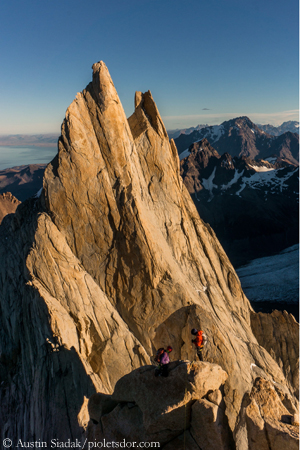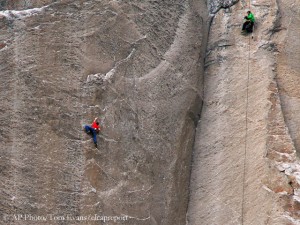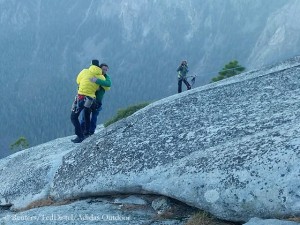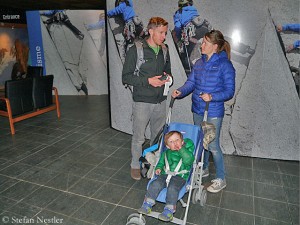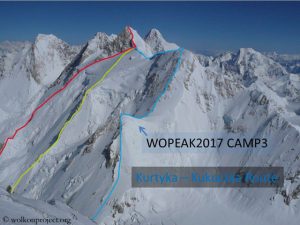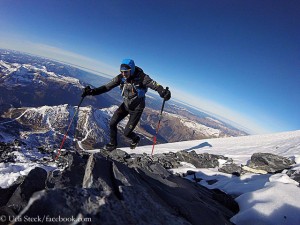Tommy Caldwell: “My heart is in Yosemite”
Tommy Caldwell is on a roll. The 36-year-old American and his compatriot Alex Honnold won this year’s Piolet d’Or, the “Oscar for climbers”, for their success in completing the so called “Fitz Traverse” in Patagonia, a more than five kilometers long climbing route over seven summits and some razor sharp ridges. And Tommy is a prime candidate for next year’s award too. Last January he and Kevin Jorgeson free-climbed for the first time the extremely difficult about 900-meter-high route Dawn Wall on El Capitan in Yosemite – a real milestone in big wall climbing. I talked to Tommy about both climbs.
Tommy, you and Alex Honnold were awarded the Piolet d’Or for succeeding the Fitz Traverse in Patagonia. How did you experience this outstanding climb?
It was definitely a hard climb for me. It was so outside of everyday life. So if you look back at it, it doesn’t seem real. It wasn’t something I had planned. We went to Patagonia not knowing what we were going to climb. That was one idea, but I thought it was too big, I never thought we could do it. But then there was a big weather window and we decided to just go big.
For Alex, it was the first time that he was on expedition in Patagonia. What was it like for you to climb with him the Fitz Traverse?
It was amazing. He is the ultimate climbing partner. I knew that his skills would transfer from Yosemite to Patagonia really well. He doesn’t like being cold, I was a little worried about that. But since the experience was so intense and amazing, he was okay dealing with the cold a few days. Sometimes we were going a mile and not even seeing each other because we were on opposite sides of the rope. Our systems are so dialed that we don’t have to say a word to each other.
Is it possible to compare the Fitz Traverse in Patagonia and the Dawn Wall in Yosemite that you free-climbed in team with Kevin Jorgeson at the turn of the year?
They are so different in style. I trained very hard for the Dawn Wall. For seven years it was on the top of my mind the whole time. That training prepared me for Patagonia well, but the style of climbing was so different. The Fitz Traverse just happened, it wasn’t really a plan. The Dawn Wall was very planned, I focused all my energy into that. There we had people bringing us food and tons of gear when we were up there for all this time. The Fitz Traverse was completely the opposite. We had one 25 liter and one 335 liter backpack, just barely enough food, only one sleeping bag.
Caldwell: So different in style
What does it mean to you to have succeeded free-climbing the Dawn Wall?
It means that this relationship that I have had for seven years is ending. It’s hard actually. A lot of people would think that the end of this goal is a great moment. For me it was good because I reached my goal, but this life driving force that I had for so long is no longer there.
So, are you now going through a valley?
(He laughs) Yeah, probably. I’m working on writing a book now. So I have something to focus my energy into. That’s how I am, I always find a goal and I very intensely pursue that. So right now I have to write a book, but I’m expecting at some point to go through a bit of a valley. I’m sure.
You were 19 days in the wall. What was the hardest during this climb?
The hardest part of the Dawn Wall for me was actually the preparation before the climb: trying to figure out ways to better climbing, sometimes feeling like it wasn’t working. Once we got on the wall for that 19-day-push, things went really well for me. My partner on the other hand struggled; he wasn’t nearly as prepared as I was. He struggled pretty hard, so I waited around. I had to become very good support for him, which was fun for me too. I wouldn’t say it was a hard experience, but there were moments where we worried about whether we were going to make it together.
Caldwell: The hardest part was the preparation
When Kevin had problems, did you think for a moment that you would have to do it alone?
Luckily I never had to come to that. I didn’t want to top out without Kevin. I don’t know honestly whether I would have done it if he had given up completely. He might have told me that I have to continue.
If two climbers have done such an amazing thing together, does it change the attitude between them? Are you now another kind of friends?
Every climbing relationship is different. Alex Honnold is the kind of person I would call if I was having a hard time in life. He is like a really close friend. Kevin is also a close friend but in a very different way. We pretty much only talk when we are climbing together. But when we are climbing together, it works so well and it’s so amazing. I admire Kevin so much, but it’s almost more like a business relationship whereas most of my other climbing partners, it’s like deep friendship, almost like family.
Caldwell about climbing relationships
There was a little bit of criticism about the great media coverage of your climb. Cameramen were hanging in the wall. There was a video live stream during the last days. What would you answer to these critics?
I would say that this media coverage was not something that we sought out at all, it just happened. We were open to it, we allowed it to happen, but it was not by design at all. It was purely because so many people were interested. There was a point when they said: There are going to be a lot of reporters on top when you get up there. And I said: I don’t really want that. But you can’t control it. Yosemite is a public place. People can come if they want.
What do you answer people who say: This man is crazy doing such things?
Nobody says that. (He laughs) The whole process of climbing the Dawn Wall was such a life driving force for me that I think, if you were in my head the whole time you would totally understand it. But most people won’t, so I don’t expect them to understand it.
Did you close the chapter Yosemite after having finished your Dawn Wall project?
Yosemite always has been and will be part of my life. I don’t know if I pursue giant projects like the Dawn Wall anymore, but I am going to continue to go to Yosemite. I live in Colorado physically, but my heart is in Yosemite.
You lost one finger in an accident with a table saw in 2001. How is it possible to do such extreme climbs with only nine fingers?
When I chopped off my finger, I was already a quite serious climber. I didn’t want to lose professionally climbing as my way to live, and so I became very focused and dedicated at a kind of overcoming that injury. It made me mentally stronger. The biggest growth in my climbing I think was right after chopping off my finger. I was a sport climber and a boulderer before and I started to gravitate more towards big wall and mountains, because I knew that I could never be the best competition climber with nine fingers. Big wall climbing is a bit less finger strength intense.
You have also been on expedition to high mountains. In 2000, in Kirghizstan you were kidnapped. Was this an experience that made you avoid expeditions to high mountains?
No. What happened in Kirghizstan had nothing to do with the fact that we were even in the mountains. We got into the middle of a political struggle.
But it was very narrow for you.
Yes, but I am still going to save high mountains in the world. I think I don’t go to very high mountains because of avalanche danger. I have 25 friends in my life that have died in high mountains. I am a dad. I want to live a long time. So I pick climbs that I feel that the danger is more controllable.
So, no 8000 meter peaks?
I don’t have it in my plans. But if I find a beautiful route on a 8000 meter peak that I felt like was not in danger of rock fall, big avalanches, big crevasse danger, I would climb it.
You are a husband and father. Has this made you more cautious?
I think I view my life through a lens of having people who rely on me. I feel a lot of responsibility to be there for them. So, as I said, I pick climbs where I feel like the objective hazards are manageable. I don’t want to die in the mountains.
Caldwell:I don’t want to die in the mountains
P.S. I made this interview with Tommy already in April, at the Piolet d’Or celebrations in Chamonix. But when I actually wanted to publish it, the strong earthquake hit Nepal and I had to cover this tragedy…




